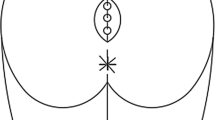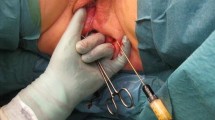Abstract
Background
Pilonidal sinus disease (PSD) is a frequent disorder. Treatment failure and recurrence are common, leading to significant morbidity. The aim of this study was to investigate the impact and need for repeated treatment of injected autologous adipose tissue into non-healing PSD wounds and primary anal-near PSD or anal-near recurrence.
Methods
At the Department of Surgery, Randers Regional Hospital, Denmark, a prospective pilot study was conducted on consecutive PSD patients with lack of healing 3 months after surgery (Bascom’s cleft lift) or with primary or recurrent anal-near pilonidal sinus disease from December 2018 to March 2020. The primary endpoint was time to healing. Autologous adipose tissue was harvested from the patients and injected into the lesions after surgical revision. Patients were examined 2 and 12 weeks after surgery. Patients with lack of healing after 12 weeks (undermining or no skin coverage) were offered re-injection.
Results
We included 30 patients [26 men and 4 women, median age 24 years (range 18–59 years)]. Complete healing was achieved in 25 patients [83.3%; 95% CI (69.9–96.7)]. Two patients had recurrence (6.7%). The median time to complete healing was 159 (189) days. The mean operation time was 70.6 ± 23.7 min and the mean amount of injected autologous adipose tissue was 19 ± 10 ml. There were no major complications.
Conclusion
Freshly collected autologous adipose tissue injected into chronic non-healing or primary and recurrent PSD lesions near the anal verge is safe and efficient.


Similar content being viewed by others
References
Evers T, Doll D, Matevossian E, Noe S, Neumann K, Li HL et al (2011) Trends in incidence and long-term recurrence rate of pilonidal sinus disease and analysis of associated influencing factors. Zhonghua Wai Ke Za Zhi 49(9):799–803
Doll D, Friederichs J, Dettmann H, Boulesteix AL, Duesel W, Petersen S (2008) Time and rate of sinus formation in pilonidal sinus disease. Int J Colorectal Dis 23(4):359–364
Al-Khamis A, McCallum I, King PM, Bruce J (2010) Healing by primary versus secondary intention after surgical treatment for pilonidal sinus. Cochrane Database Syst Rev. https://doi.org/10.1002/14651858.CD006213.pub3
Bendewald FP, Cima RR (2007) Pilonidal disease. Clin Colon Rectal Surg 20(2):86–95
Bascom J, Bascom T (2002) Failed pilonidal surgery: new paradigm and new operation leading to cures. Arch Surg 137(10):1146–1150
Berthier C, Bérard E, Meresse T, Grolleau JL, Herlin C, Chaput B (2019) A comparison of flap reconstruction vs the laying open technique or excision and direct suture for pilonidal sinus disease: a meta-analysis of randomised studies. Int Wound J 16(5):1119–1135
Stauffer VK, Luedi MM, Kauf P, Schmid M, Diekmann M, Wieferich K et al (2018) Common surgical procedures in pilonidal sinus disease: a meta-analysis, merged data analysis, and comprehensive study on recurrence. Sci Rep 8(1):3058
Iesalnieks I, Ommer A (2019) The management of pilonidal sinus. Dtsch Arztebl Int 116(1–2):12–21
Woo KY, Kwong EW, Jimenez C, Bishop R (2015) Topical agents and dressings for pilonidal sinus wound healing by secondary intention: a scoping review. Surg Technol Int 26:57–63
Miana VV, González EAP (2018) Adipose tissue stem cells in regenerative medicine. Ecancermedicalscience 12:822
Banyard DA, Salibian AA, Widgerow AD, Evans GR (2015) Implications for human adipose-derived stem cells in plastic surgery. J Cell Mol Med 19(1):21–30
Mizuno H, Hyakusoku H (2003) Mesengenic potential and future clinical perspective of human processed lipoaspirate cells. J Nippon Med Sch 70(4):300–306
Garcia-Olmo D, Herreros D, Pascual I, Pascual JA, Del-Valle E, Zorrilla J et al (2009) Expanded adipose-derived stem cells for the treatment of complex perianal fistula: a phase II clinical trial. Dis Colon Rectum 52(1):79–86
Herreros MD, Garcia-Arranz M, Guadalajara H, De-La-Quintana P, Garcia-Olmo D, Group FC (2012) Autologous expanded adipose-derived stem cells for the treatment of complex cryptoglandular perianal fistulas: a phase III randomized clinical trial (FATT 1: fistula Advanced Therapy Trial 1) and long-term evaluation. Dis Colon Rectum 55(7):762–772
Panés J, García-Olmo D, Van Assche G, Colombel JF, Reinisch W, Baumgart DC et al (2016) Expanded allogeneic adipose-derived mesenchymal stem cells (Cx601) for complex perianal fistulas in Crohn’s disease: a phase 3 randomised, double-blind controlled trial. Lancet 388(10051):1281–1290
Naldini G, Sturiale A, Fabiani B, Giani I, Menconi C (2018) Micro-fragmented adipose tissue injection for the treatment of complex anal fistula: a pilot study accessing safety and feasibility. Tech Coloproctol 22(2):107–113
Dige A, Hougaard HT, Agnholt J, Pedersen BG, Tencerova M, Kassem M et al (2019) Efficacy of injection of freshly collected autologous adipose tissue into perianal fistulas in patients with crohn’s disease. Gastroenterology 156(8):2208–16.e1
Andjelkov K, Sforza M, Barisic G, Soldatovic I, Hiranyakas A, Krivokapic Z (2017) A novel method for treatment of chronic anal fissure: adipose-derived regenerative cells - a pilot study. Colorectal Dis 19(6):570–575
Deng C, Wang L, Feng J, Lu F (2018) Treatment of human chronic wounds with autologous extracellular matrix/stromal vascular fraction gel: a STROBE-compliant study. Medicine (Baltimore) 97(32):e11667
Umesh V, Sussman RH, Smith J, Whyte C (2018) Long term outcome of the Bascom cleft lift procedure for adolescent pilonidal sinus. J Pediatr Surg 53(2):295–297
Bascom J (1980) Pilonidal disease: origin from follicles of hairs and results of follicle removal as treatment. Surgery 87(5):567–572
Korsgaard PDSM, Pedersen AG, Friis ML, Haas S (2021) Patient impact of pilonidal disease. Pilonidal Sinus J 7(1):32–40
Harris PA, Taylor R, Thielke R, Payne J, Gonzalez N, Conde JG (2009) Research electronic data capture (REDCap)–a metadata-driven methodology and workflow process for providing translational research informatics support. J Biomed Inform 42(2):377–381
Harris PA, Taylor R, Minor BL, Elliott V, Fernandez M, O’Neal L et al (2019) The REDCap consortium: Building an international community of software platform partners. J Biomed Inform 95:103208
Elfeki H, Sørensen MJ, Pedersen AG, Lundby L, Haas S (2019) Injection of freshly collected autologous adipose tissue for treatment of a non-healing sacrococcygeal pilonidal disease patient - a video vignette. Colorectal Dis 21(11):1341
Haas S, Sørensen MJ, Lundby L, Pedersen AG (2020) Injection of freshly collected autologous adipose tissue into non-healing wounds after closed incision pilonidal surgery. Tech Coloproctol 24:1301–1306
Bascom J, Bascom T (2007) Utility of the cleft lift procedure in refractory pilonidal disease. Am J Surg 193(5):606–609
Allen-Mersh TG (1990) Pilonidal sinus: finding the right track for treatment. Br J Surg 77(2):123–132
Lund J, Tou S, Doleman B, Williams JP (2017) Fibrin glue for pilonidal sinus disease. Cochrane Database Syst Rev. https://doi.org/10.1002/14651858.CD011923.pub2
Mostafaei S, Norooznezhad F, Mohammadi S, Norooznezhad AH (2017) Effectiveness of platelet-rich plasma therapy in wound healing of pilonidal sinus surgery: a comprehensive systematic review and meta-analysis. Wound Repair Regen 25(6):1002–1007
Spyridakis M, Christodoulidis G, Chatzitheofilou C, Symeonidis D, Tepetes K (2009) The role of the platelet-rich plasma in accelerating the wound-healing process and recovery in patients being operated for pilonidal sinus disease: preliminary results. World J Surg 33(8):1764–1769
Mahmood F, Hussain A, Akingboye A (2020) Pilonidal sinus disease: review of current practice and prospects for endoscopic treatment. Ann Med Surg (Lond) 57:212–217
Funding
Department of Surgery, Randers Regional Hospital.
Author information
Authors and Affiliations
Contributions
Study design: SH, MSJ, AGP, HH, and LL; data collection: SH, MSJ, HH, AGP, and SGV; data analysis: SGV and SH; interpretation of results: all the co-authors; manuscript preparation: SGV and SH; critical revision of manuscript: all the co-authors.
Corresponding authors
Ethics declarations
Conflict of interest
The authors declare that they have no conflict of interest.
Additional information
Publisher's Note
Springer Nature remains neutral with regard to jurisdictional claims in published maps and institutional affiliations.
Rights and permissions
Springer Nature or its licensor holds exclusive rights to this article under a publishing agreement with the author(s) or other rightsholder(s); author self-archiving of the accepted manuscript version of this article is solely governed by the terms of such publishing agreement and applicable law.
About this article
Cite this article
Sophie, V.G., Marlene, S.J., Helene, H.T. et al. Injection of freshly collected autologous adipose tissue in complicated pilonidal disease: a prospective pilot study. Tech Coloproctol 26, 883–891 (2022). https://doi.org/10.1007/s10151-022-02683-0
Received:
Accepted:
Published:
Issue Date:
DOI: https://doi.org/10.1007/s10151-022-02683-0




